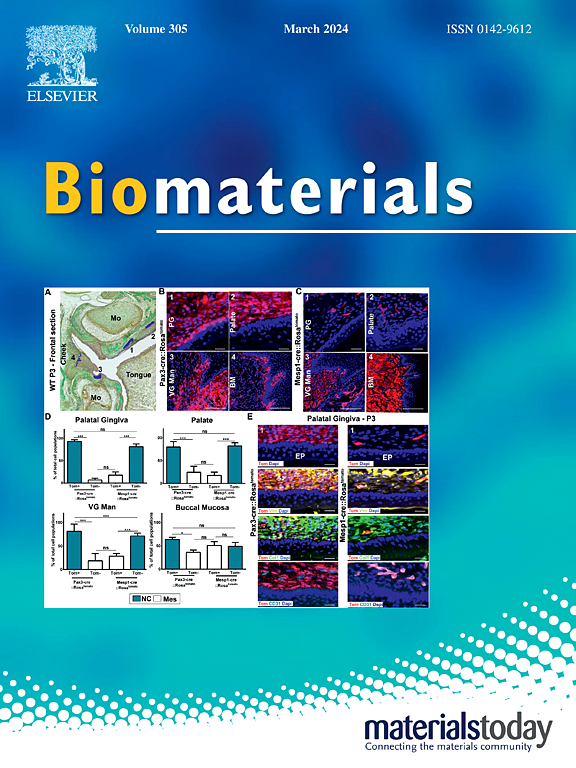通过抑制Lcn2调控星形细胞表型对缺血性脑卒中的治疗。
IF 12.9
1区 医学
Q1 ENGINEERING, BIOMEDICAL
引用次数: 0
摘要
星形胶质细胞在缺血再灌注损伤后可反应为“反应性星形胶质细胞”,其中A1表型导致神经元和少突胶质细胞死亡,而A2表型具有神经保护作用,因此将反应性星形胶质细胞调节为A2型是卒中治疗的潜在靶点。Lcn2水平与星形胶质细胞表型极化高度相关。我们发现,通过腺相关病毒(AAV)-Lcn2 shRNA腺病毒沉默Lcn2基因可导致MCAO小鼠的a1型星形胶质细胞显著减少,A2型星形胶质细胞显著增加。因此,研究人员开发了一种通过抑制Lcn2来治疗中风的纳米平台。该系统是由n -乙酰基Pro-Gly-Pro肽修饰的棒状聚乳酸-羟基乙酸纳米颗粒与罗利普兰(AP@R)负载制备的。该纳米药物可以通过形态介导的被动靶向和Cxcr2受体介导的主动靶向同时被中性粒细胞有效吸收,随后通过搭车中性粒细胞穿过血脑屏障(BBB)。释放的罗利普兰在脑实质积聚时,可抑制Lcn2水平,从而逆转星形胶质细胞表型,减轻神经炎症,促进血脑屏障修复。本研究为缺血性脑卒中的治疗提供了一种新的策略。本文章由计算机程序翻译,如有差异,请以英文原文为准。
Regulating astrocyte phenotype by Lcn2 inhibition toward ischemic stroke therapy
Astrocytes can be reacted to “reactive astrocytes” after ischemia-reperfusion injury, in which A1 phenotype causes neuronal and oligodendrocyte death, whereas the A2 phenotype exerts neuroprotective effects, thus regulating reactive astrocyte to A2 type is a potential target for stroke therapy. Lcn2 level is highly associated with the phenotypic polarization of astrocytes. We found that silencing the Lcn2 gene by adeno-associated virus (AAV)-Lcn2 shRNA adenovirus resulted in a dramatic decrease in A1-type astrocytes and increase in A2 astrocytes in MCAO mice. Hence, a nanoplatform was developed for stroke therapy by inhibiting Lcn2. This system was fabricated by N-acetyl Pro-Gly-Pro peptide-decorated rod-shaped poly (lactic-co-glycolic acid) nanoparticles loading with rolipram (AP@R). The nanodrug can be efficiently taken up by neutrophils simultaneously through morphology-mediated passive targeting and Cxcr2 receptor-mediated active targeting, subsequently crossing the blood-brain barrier (BBB) by hitchhiking neutrophils. When accumulating at the brain parenchyma, the released rolipram can inhibit the Lcn2 level, thereby reversing the astrocyte phenotype to alleviate neuroinflammation and promote BBB repair. This work provides a new strategy for treating ischemic stroke.
求助全文
通过发布文献求助,成功后即可免费获取论文全文。
去求助
来源期刊

Biomaterials
工程技术-材料科学:生物材料
CiteScore
26.00
自引率
2.90%
发文量
565
审稿时长
46 days
期刊介绍:
Biomaterials is an international journal covering the science and clinical application of biomaterials. A biomaterial is now defined as a substance that has been engineered to take a form which, alone or as part of a complex system, is used to direct, by control of interactions with components of living systems, the course of any therapeutic or diagnostic procedure. It is the aim of the journal to provide a peer-reviewed forum for the publication of original papers and authoritative review and opinion papers dealing with the most important issues facing the use of biomaterials in clinical practice. The scope of the journal covers the wide range of physical, biological and chemical sciences that underpin the design of biomaterials and the clinical disciplines in which they are used. These sciences include polymer synthesis and characterization, drug and gene vector design, the biology of the host response, immunology and toxicology and self assembly at the nanoscale. Clinical applications include the therapies of medical technology and regenerative medicine in all clinical disciplines, and diagnostic systems that reply on innovative contrast and sensing agents. The journal is relevant to areas such as cancer diagnosis and therapy, implantable devices, drug delivery systems, gene vectors, bionanotechnology and tissue engineering.
 求助内容:
求助内容: 应助结果提醒方式:
应助结果提醒方式:


